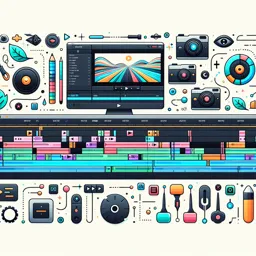Adobe Premiere Pro has integrated various AI-powered tools to help editors streamline their workflow, reduce repetitive tasks, and produce high-quality content more efficiently. These tools, part of Adobe’s Sensei AI framework, bring new possibilities for automating tedious processes like scene edits, audio leveling, and even motion tracking. In this article, we’ll explore the key AI features in Adobe Premiere and how to use them to speed up your video editing process.
1. Auto Reframe: Simplifying Aspect Ratio Adjustments
One of the standout AI tools in Adobe Premiere is Auto Reframe. This feature automatically adjusts video content to different aspect ratios, making it ideal for creating content for various platforms like Instagram, YouTube, and TikTok without losing the focal points.
How to Use It:
- Right-click on the sequence in the Project panel.
- Choose Auto Reframe Sequence.
- Select the target aspect ratio (e.g., 9:16 for vertical videos).
- Premiere will automatically reframe the video, keeping the main subject in focus.
This tool is especially useful for content creators who need to adapt a single video for multiple social media platforms.
2. Scene Edit Detection: Faster Cuts for Long Footage
Manually cutting long footage into separate scenes can be time-consuming. Adobe’s Scene Edit Detection uses AI to detect scene changes and automatically creates cuts in your timeline, saving hours of manual editing.
How to Use It:
- Select your clip in the timeline.
- Right-click and choose Scene Edit Detection.
- Premiere will analyze the clip and create cuts at each scene change.
This feature is perfect for editing older projects, interviews, or multi-camera setups where you need to isolate specific sections quickly.
3. Speech to Text: Automating Captions and Subtitles
Adding captions and subtitles has traditionally been a labor-intensive task. The new Speech to Text tool automates this process using AI to transcribe your video’s dialogue and generate captions within minutes.
How to Use It:
- Navigate to the Captions and Graphics workspace.
- Click on Transcribe Sequence.
- Premiere will analyze the audio and produce a transcript.
- Click Create Captions to automatically generate a caption track.
This tool not only saves time but also improves accessibility and engagement, especially for social media content where subtitles are crucial.
4. Remix Tool: Adjusting Audio Length Seamlessly
Adobe Premiere’s Remix Tool uses AI to intelligently shorten or extend music tracks to fit your video’s length without losing musicality. This is ideal for editors looking to customize audio tracks without needing advanced audio editing skills.
How to Use It:
- Select an audio track in the timeline.
- Go to Essential Sound Panel and choose Music.
- Enable Remix and set the desired duration.
- Premiere will analyze the music and automatically recompose it to match the specified length.
This feature is particularly useful for creating trailers, promotional videos, and any content where background music needs to align with the visuals.
5. Color Match: Consistent Color Grading with a Click
Maintaining consistent color grading across multiple clips is challenging. Adobe’s Color Match feature uses AI to match the color of different clips to a reference clip, ensuring visual uniformity throughout your project.
How to Use It:
- Go to the Color Panel.
- Select the clip you want to match.
- Choose a reference clip and click Apply Match.
This tool is excellent for documentary editors, wedding filmmakers, or anyone working with footage from different cameras or lighting conditions.
6. Auto-Ducking: Perfect Audio Levels Instantly
Balancing dialogue, music, and sound effects can be tricky. Auto-Ducking, found in the Essential Sound Panel, uses AI to automatically lower the volume of background music when dialogue is detected, creating a polished, professional sound mix.
How to Use It:
- Tag your dialogue track as Dialogue.
- Tag your music track as Music.
- Enable Auto-Ducking under the Music settings.
Premiere will automatically adjust audio levels, saving time and reducing the need for manual keyframing.
Conclusion
Adobe Premiere’s AI tools are designed to help editors focus on creativity by automating repetitive tasks. Features like Auto Reframe, Scene Edit Detection, and Speech to Text are game-changers for speeding up the editing process, making Premiere more efficient and accessible for both professionals and beginners. By incorporating these tools into your workflow, you can edit faster and more effectively, freeing up more time to focus on storytelling and visual quality.
































